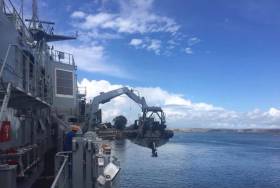Displaying items by tag: Appledore, Devon
Proposed Clean Maritime Innovation Centre at Appledore, north Devon Receives £15.6mn Investment
In south-west England, Torridge District Council has received its largest ever investment of £15.6mn to boost and develop its proposed Clean Maritime Innovation Centre at Middle Dock located next to Harland & Wolff’s Appledore shipyard.
The funding for the Centre was issued by the Department for Levelling Up, Housing and Communities in order to establish Torridge and wider northern Devon as a global-leading research and development hub for innovation in clean maritime technology and support industry.
Set to launch in 2025, the centre will display key industry partnerships from the Centre of Future Clean Mobility (CFCM) at the University of Exeter and the University of Plymouth offshore renewable and maritime autonomy specialisms, as well as state of the art research. This project is expected to propel the repositioning of Appledore as a region of excellence for clean-propulsion shipbuilding, as advancements away from diesel heighten over the next few years.
Tom Hart, General Manager at Harland & Wolff Appledore added: ‘’We are excited to hear about the approvals for the maritime innovation centre in Appledore. This will bring a vast amount of innovation into the industry, as well as opportunities for Harland & Wolff through research and development into net zero vessels for the future.
He added “this new development will undoubtedly place our Appledore facility in the heart of a green shipbuilding centre of excellence and will generate the technical expertise required to support a new generation of clean vessels as we move to net zero.’’
Could Mystery Boatman Steer Appledore, Devon Shipyard's Future
#Ports&Shipping - A mystery that has got the City's of London's defence and industry experts speculating: just who is behind Boatman Capital Research?
As Sky News reports, Boatman last week published a damning report on Babcock, the engineering services group, which is credited with knocking £130m - or 4% - from the company's stock market valuation.
Its opening paragraph says: "Our investigative team has been researching Babcock for the past six months.
"We have reviewed hundreds of pages of company accounts, government documents and have interviewed numerous sources in the defence sector.
"In our opinion, Babcock has systematically misled investors by burying bad news about its performance.
"We believe that Babcock's senior leadership team - specifically the chairman and chief executive - are not up to the job and their failings will damage the company's future prospects."
For much more on the uncertain future that awaits the West Country shipyard dating to 1855 (click here)
Afloat adds in much more recent times the yard on the River Torridge near Bideford built for the Irish Naval Service, the OPV80/P50 'Roisin' class pair LÉ Roisin in 1999 and two years later LÉ Niamh. This took place when the yard was under ownership of Appledore Shipbuilders, a subsidiary of Langham Industries.
Other orders for Irish interests included Arklow Shipping, when the facility built a pair of bulk-carriers during the early 1990's. The sisters each 7,182dwt, Arklow Brook and Arklow Bridge were sold in recent years as previously reported in Ports & Shipping news.
Plus Appledore constructed the current Shannon Ferries operated double-ended car-ferries, Shannon Dolphin in 1995 and larger half-sister Shannon Breeze in 2000.




























































